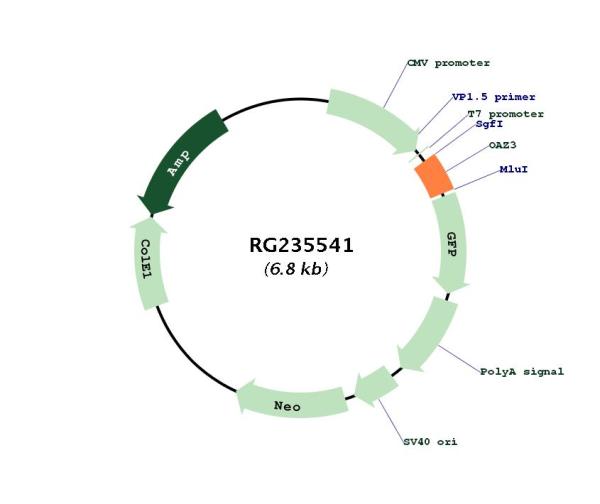OAZ3 (NM_001301371) Human Tagged ORF Clone
CAT#: RG235541
- TrueORF®
OAZ3 (tGFP-tagged) - Human ornithine decarboxylase antizyme 3 (OAZ3), transcript variant 3
ORF Plasmid: DDK
"NM_001301371" in other vectors (2)
Specifications
| Product Data | |
| Tag | TurboGFP |
| Symbol | OAZ3 |
| Synonyms | AZ3; OAZ-t; TISP15 |
| Vector | pCMV6-AC-GFP |
| E. coli Selection | Ampicillin (100 ug/mL) |
| Mammalian Cell Selection | Neomycin |
| Sequence Data |
>RG235541 representing NM_001301371.
Blue=ORF Red=Cloning site Green=Tag(s) GCTCGTTTAGTGAACCGTCAGAATTTTGTAATACGACTCACTATAGGGCGGCCGGGAATTCGTCGACTG GATCCGGTACCGAGGAGATCTGCCGCCGCGATCGCC ATGAGACCTGAGGGAGGACCCCGGCGTCGGCGGCAGGAAAGGCCCCCGCCAGTGCTGCCTGCGGCGCGC CGCATCACTTATAAGGAAGAGGAGGACTTGACACTCCAGCCCCGTTCCTGCCTCCAGTGCTCCATGAGA CCTGAGGGAGGACCCCGGCGTCGGCGGCAGGAAAGGCCCCCGCCAGTGCTGCCTGCGGCGCGCCGCATC ACTTATAAGGAAGAGGAGGACTTGACACTCCAGCCCCGTTCCTGCCTCCAGTGCTCC ACGCGTACGCGGCCGCTCGAG - GFP Tag - GTTTAAAC >Peptide sequence encoded by RG235541
Blue=ORF Red=Cloning site Green=Tag(s) MRPEGGPRRRRQERPPPVLPAARRITYKEEEDLTLQPRSCLQCSMRPEGGPRRRRQERPPPVLPAARRI TYKEEEDLTLQPRSCLQCS TRTRPLEMESDESGLPAMEIECRITGTLNGVEFELVGGGEGTPEQGRMTNKMKSTKGALTFSPYLLSHV MGYGFYHFGTYPSGYENPFLHAINNGGYTNTRIEKYEDGGVLHVSFSYRYEAGRVIGDFKVMGTGFPED SVIFTDKIIRSNATVEHLHPMGDNDLDGSFTRTFSLRDGGYYSSVVDSHMHFKSAIHPSILQNGGPMFA FRRVEEDHSNTELGIVEYQHAFKTPDADAGEERV |
| Restriction Sites |
SgfI-MluI
Cloning Scheme for this gene
Plasmid Map

|
| ACCN | NM_001301371 |
| ORF Size | 264 bp |
| OTI Disclaimer | The molecular sequence of this clone aligns with the gene accession number as a point of reference only. However, individual transcript sequences of the same gene can differ through naturally occurring variations (e.g. polymorphisms), each with its own valid existence. This clone is substantially in agreement with the reference, but a complete review of all prevailing variants is recommended prior to use. More info |
| OTI Annotation | This clone was engineered to express the complete ORF with an expression tag. Expression varies depending on the nature of the gene. |
| Product Components | The ORF clone is ion-exchange column purified and shipped in a 2D barcoded Matrix tube containing 10ug of transfection-ready, dried plasmid DNA (reconstitute with 100 ul of water). |
| Reference Data | |
| RefSeq | NM_001301371, NP_001288300 |
| RefSeq Size | 753 bp |
| RefSeq ORF | 613 bp |
| Locus ID | 51686 |
| UniProt ID | Q9UMX2 |
| Cytogenetics | 1q21.3 |
| MW | 10.8 kDa |
| Gene Summary | The protein encoded by this gene belongs to the ornithine decarboxylase antizyme family, which plays a role in cell growth and proliferation by regulating intracellular polyamine levels. Expression of antizymes requires +1 ribosomal frameshifting, which is enhanced by high levels of polyamines. Antizymes in turn bind to and inhibit ornithine decarboxylase (ODC), the key enzyme in polyamine biosynthesis; thus, completing the auto-regulatory circuit. This gene encodes antizyme 3, the third member of the antizyme family. Like antizymes 1 and 2, antizyme 3 inhibits ODC activity and polyamine uptake; however, it does not stimulate ODC degradation. Also, while antizymes 1 and 2 have broad tissue distribution, expression of antizyme 3 is restricted to haploid germ cells in testis, suggesting a distinct role for this antizyme in spermiogenesis. Antizyme 3 gene knockout studies showed that homozygous mutant male mice were infertile, and indicated the likely role of this antizyme in the formation of a rigid connection between the sperm head and tail during spermatogenesis. Alternatively spliced transcript variants encoding different isoforms, including one resulting from the use of non-AUG (CUG) translation initiation codon, have been found for this gene. [provided by RefSeq, Dec 2014] |
Documents
| Product Manuals |
| FAQs |
| SDS |
Resources
{0} Product Review(s)
Be the first one to submit a review






























































































































































































































































 Germany
Germany
 Japan
Japan
 United Kingdom
United Kingdom
 China
China

